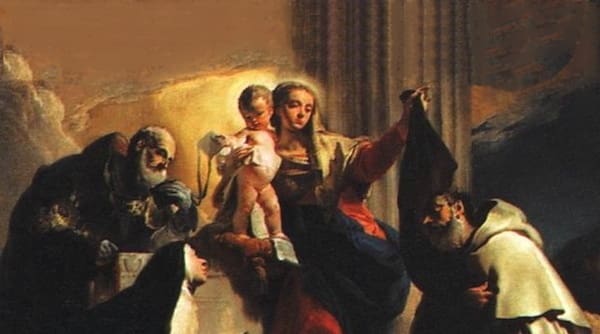Throughout the centuries, there have been many variations of the Rosary as Christians adapted it to fit particular situations. In Rosarium Virginis Mariae, Saint John Paul II proposed a renewed way of praying the Rosary, but he did not insist that everyone should use this new way. Instead, he desired to revitalize the Rosary for a new generation.
Keep in mind this wise saying of Saint Teresa: “Do that which best stirs you to love.” If you have a favorite practice that helps make your recitation of the Rosary more contemplative, do not think you must change it just because Saint John Paul II gave different suggestions or because the meditations we offer in this article or in our book are different from the ones you have used before.
Sometimes we need a slight change in our prayer practice in order to help us refocus and grow. But other times, when we are on a proven and fruitful path, we need to remain on that path. There are few hard-and-fast rules about praying the Rosary. Follow the general guidance for making vocal prayer more contemplative. The specific practices you use are of lesser importance. These specifics are meant to facilitate your Contemplative Rosary, not to bind you permanently to one set of meditations or a select group of paintings.
One good custom is to begin the Rosary with the Apostles’ Creed, then an Our Father and three Hail Marys for the intentions of the Pope as a way of orienting our hearts to the universal and ecclesial nature of the Rosary. Saint John Paul II writes that the opening words of Psalm 70: “O God, come to my [assistance]; O Lord, make haste to help me,” might be prayed at the beginning of the Rosary instead, indicating our need of God’s help in order to pray worthily. This verse is recited at the beginning of Morning and Evening Prayer by those who pray the Liturgy of the Hours. It thus connects the Rosary more closely with the official prayers of the Church.
The Mysteries
Saint John Paul II encourages the use of icons or other representations of each mystery. As Saint Teresa suggests, using our senses or imagination helps to keep our otherwise distracted minds on God. Jesus Himself is an icon, an image of the invisible God. Therefore, it is fitting to use images to help us come closer to Him.
Many people, especially when they pray the Rosary in a group, are used to reading a short passage from Scripture after each mystery is announced. The Pope encourages us to practice this whenever we pray the Rosary. Doing so makes Sacred Scripture a vital part of the Rosary, connecting this prayer to the Liturgy and to our own time of mental prayer, when we meditate only on the sacred text. It reminds us that prayer is not only about speaking to God, but also about listening to Him. We listen to His Word and then respond to it as we say the prayers for each mystery. The reading can be long or short, and even accompanied by a short homily in solemn celebrations. After this proclamation of the Word, a short silence is fitting.
Saint John Paul II also proposed another set of mysteries that many of us are now familiar with: the Mysteries of Light (Luminous Mysteries). These scenes from the Gospels fill in the gap between Christ’s childhood and His Passion with events from His public ministry. The Mysteries of Light are: the Baptism of the Lord, the Wedding at Cana, the Proclamation of the Kingdom, the Transfiguration, and the Institution of the Eucharist. They have a distinctly sacramental character not found in the traditional fifteen mysteries. They remind us that our salvation is revealed not just in Jesus’ life two thousand years ago, but also in Baptism, Matrimony, the Eucharist, and the other sacraments. The Pope notes that only the second of these mysteries explicitly mentions Mary. Yet the instruction she gives to the servants at the Wedding at Cana “becomes the great maternal counsel which Mary addresses to the Church of every age: ‘Do whatever He tells you’ ” (John 2:5). Her words form the foundation of this entire group of mysteries.
Our Father
Jesus came to lead us to God the Father. It is therefore right for us to begin each decade by addressing God as Our Father. He is the Father of Jesus and, through Jesus, the Father of all of us. The Our Father reminds us that we are part of God’s family, in communion with one another, even when we pray the Rosary alone.
Studying Saint Teresa’s exposition of the Our Father in chapters 24 through 42 of The Way of Perfection would be an excellent means of enriching our prayer.
Hail Mary
The Hail Mary is the central prayer of the Rosary. If we pray the entire Rosary according to the new form offered by Saint John Paul II, we say the Hail Mary two hundred times. How can we pray this prayer in a more contemplative manner?
Saint John Paul II calls the Hail Marys the threads over which the mysteries of the Rosary are woven. They present to us in miniature the mystery of the God-Man, the same mystery presented to us on a larger scale throughout the Rosary.
The Hail Mary is a profoundly Christ-centered prayer. Rather than taking our eyes off Christ, it focuses our attention on Him. It begins with the greeting of the Angel Gabriel at the Annunciation, coupled with the words of Saint Elizabeth at the Visitation. It ends with our supplication for Mary’s maternal care for us and our loved ones, in light of our union with her divine Son. It calls us to share in God’s delight in the Incarnation. We contemplate the Incarnation with God Himself. Just as in the Creation He pronounced the world good, so God stood back in delight at the conception of His eternal Son in the womb of the Virgin. “The repetition of the Hail Mary in the Rosary gives us a share in God’s own wonder and pleasure: in jubilant amazement we acknowledge the greatest miracle of history.” This repetition is also like a sentence of love spoken repeatedly to one’s beloved.
In Marialis Cultus, Blessed Paul VI noted the custom of adding, after the name of Jesus, a brief statement of faith related to the mystery we are reflecting on, such as “who was conceived in you by the Holy Spirit” while meditating on the Annunciation. Saint John Paul II encourages us to take up this custom. He says that Jesus’ name is “the center of gravity” of the entire prayer, the hinge that links the two halves of the Hail Mary. Instead of mumbling the name of Jesus, as sometimes happens, we should highlight it by adding a statement that makes us pay attention. This helps us to engage with our prayer rather than just “say our prayers.” It pulls our wandering minds back to Christ and anchors them in the mystery we seek to explore.
Glory Be
Adoration of the Trinity, says Saint John Paul II, is the goal of prayer. He notes that the Glory Be, “the high-point of contemplation, [should] be given due prominence in the Rosary.” In public celebrations, we should sing it. The Glory Be transports us to Mount Tabor, the site of the Transfiguration, where we can say with St. Peter, “It is well that we are here!” It’s so easy to overlook this short prayer, making it an afterthought. However, the Incarnation we ponder in the Rosary took place so that we could worship the Holy Trinity in purity of spirit. Perhaps we should linger here a moment in silence, rather than rushing on to the next prayer.
The Church asks us to bow when we pray the Glory Be during the Liturgy of the Hours. Bowing when we pray the Glory Be in the Rosary can be another reminder of the importance of this prayer and a physical reverence that provides another aid to our desire to be fully engaged as we pray.
Concluding Prayer for Each Mystery
Many of us recite the Fatima Prayer after the Glory Be: “O my Jesus, forgive us our sins, save us from the fires of Hell, lead all souls to Heaven, especially those in most need of Thy mercy.” Saint John Paul II encourages us to say a concluding prayer asking for the grace to imitate the mystery we have just finished praying. This helps us to connect the Rosary with our daily lives.
Closing Prayer
Either beginning or concluding the Rosary with prayers for the Pope highlights again that the Rosary is a prayer not just for the individual, but for building up the whole Church. The soul may now want to “burst forth” into the Salve Regina or the Litany of Loreto. Saint John Paul II encourages us to indulge this desire.
+
This article is from a chapter in The Contemplative Rosary with St. John Paul II and St. Teresa of Avila, which is available from Sophia Institute Press. 
Art for this post on praying the rosary in a renewed way: Detail of The Madonna of Carmel and the Souls of Purgatory [Queen of Carmel], Giovanni Battista Tiepolo, 1730s, PD-US author’s life plus 100 years or less, Wikimedia Commons; Cover of The Contemplative Rosary used with permission.
Listen to Dan Burke and Connie Rossini discuss The Contemplative Rosary HERE.




